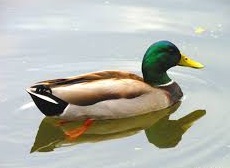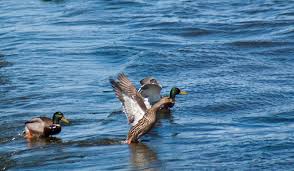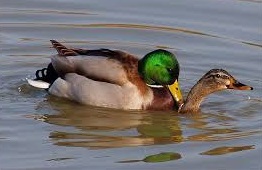The mallard or wild duck is a dabbling duck which breeds throughout the temperate and subtropical Americas,
Europe, Asia, and North Africa, and has been introduced to New Zealand, Australia, Peru, Brazil, Uruguay,
Argentina, Chile, the Falkland Islands and South Africa. This duck belongs to the subfamily Anatinae of the
waterfowl family Anatidae.
The male birds (drakes) have a glossy green head and are grey on wings and belly, while the females
(hens or ducks) have mainly brown-speckled plumage. Both sexes have an area of white-bordered black speculum
feathers which commonly also include iridescent blue feathers especially among males. Mallards live in
wetlands, eat water plants and small animals, and are social animals preferring to congregate in groups or
flocks of varying sizes. This species is the main ancestor of most breeds of domesticated ducks.
Description
The mallard is a medium-sized waterfowl species although it is often slightly heavier than most other
dabbling ducks. It is 50-65 cm (20-26 in) long (of which the body makes up around two-thirds), has a
wingspan of 81-98 cm (32-39 in), and weighs 0.72-1.58 kg (1.6-3.5 lb). Among standard measurements, the wing
chord is 25.7 to 30.6 cm (10.1 to 12.0 in), the bill is 4.4 to 6.1 cm (1.7 to 2.4 in) and the tarsus is 4.1
to 4.8 cm (1.6 to 1.9 in).
The breeding male mallard is unmistakable, with a glossy bottle-green head and white collar which demarcates
the head from the purple-tinged brown breast, grey brown wings, and a pale grey belly. The rear of the male
is black, with the dark tail having white borders. The bill of the male is a yellowish orange tipped with
black while that of the female is generally darker ranging from black to mottled orange. The female mallard
is predominantly mottled with each individual feather showing sharp contrast from buff to very dark brown, a
coloration shared by most female dabbling ducks, and has buff cheeks, eyebrow, throat and neck with a darker
crown and eye-stripe.
Owing to their highly 'malleable' genetic code, Mallards can display a large amount of variation, as seen
here with this female, who displays faded or 'apricot' plumage.
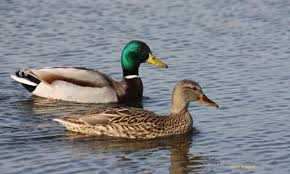
Both male and female mallards have distinct iridescent purple blue speculum feathers edged with white,
prominent in flight or at rest, though temporarily shed during the annual summer moult. Upon hatching, the
plumage colouring of the duckling is yellow on the underside and face (with streaks by the eyes) and black
on the back (with some yellow spots) all the way to the top and back of the head. Its legs and bill are also
black. As it nears a month in age, the duckling's plumage will start becoming drab, looking more like the
female (though its plumage is more streaked) and its legs will lose their dark grey colouring. Two months
after hatching, the fledgling period has ended and the duckling is now a juvenile. Between three and four
months of age, the juvenile can finally begin flying as its wings are fully developed for flight (which can
be confirmed by the sight of purple speculum feathers). Its bill will soon lose its dark grey colouring and
its sex can finally be distinguished visually by three factors. The bill colouring is yellow in males,
black and orange for females. The breast feathers are reddish-brown for males, brown for females. The centre
tail feather is curled for males (called a drake feather), straight for females.
During the final period of maturity leading up to adulthood (6-10 months of age), the plumage of female
juveniles remains the same while the plumage of male juveniles slowly changes to its characteristic
colours. This plumage change also applies to adult mallard males when they transition in and out of their
non-breeding eclipse plumage at the beginning and the end of the summer moulting period. The adulthood age
for mallards is 14 months and the average life expectancy is 3 years, but they can live to twenty.
Several species of duck have brown-plumaged females which can be confused with the female mallard. The
female gadwall (A. strepera) has an orange-lined bill, white belly, black and white speculum which is seen
as a white square on the wings in flight, and is a smaller bird. More similar to the female mallard in
North America are the American black duck (A. rubripes), which is notably darker hued in both sexes than
the mallard, and the mottled duck (A. fulvigula), which is somewhat darker than the female mallard, with no
white edge on the speculum and slightly different bare-part colouration.
In captivity, domestic ducks come in wild-type plumages, white, and other colours. Most of these colour
variants are also known in domestic mallards not bred as livestock, but kept as pets, aviary birds, etc.,
where they are rare but increasing in availability.
A noisy species, the female has a deeper quack stereotypically associated with ducks. Male mallards also
make a sound which is phonetically similar to that of the female, but it is a deep and raspy sound which can
also sound like mek or whak. When incubating a nest, or when offspring are present, Females vocalise
differently, making a call which sounds like a truncated version of the usual quack. They will also hiss if
the nest or their offspring are threatened or interfered with.
The mallard is a rare example of both Allen's Rule and Bergmann's Rule in birds. Bergmann's Rule, which
states that polar forms tend to be larger than related ones from warmer climates, has numerous examples in
birds. Allen's Rule says that appendages like ears tend to be smaller in polar forms to minimize heat loss,
and larger in tropical and desert equivalents to facilitate heat diffusion, and that the polar taxa are
stockier overall. Examples of this rule in birds are rare, as they lack external ears. However, the bill of
ducks is very well supplied with blood vessels and is vulnerable to cold.
Due to the malleability of the mallard's genetic code, which gives it its vast interbreeding capability,
mutations in the genes that decide plumage colour are very common and have resulted in a wide variety of
hybrids such as Brewer's duck (mallard × gadwall, Anas strepera).
Distribution and habitat
The mallard is widely distributed across the Northern and Southern Hemispheres; in North America from
southern and central Alaska to Mexico, the Hawaiian Islands, across Eurasia, from Iceland and southern
Greenland and parts of Morocco (North Africa) in the west, Scandinavia to the north, and to Siberia, Japan,
and South Korea, in the east, Australia and New Zealand in the Southern hemisphere. It is strongly migratory
in the northern parts of its breeding range, and winters farther south. For example, in North America, it
winters south to Mexico, but also regularly strays into Central America and the Caribbean between September
and May.
The mallard inhabits a wide range of habitat and climates, from Arctic tundra to subtropical regions. It is
found in both fresh- and salt-water wetlands, including parks, small ponds, rivers, lakes and estuaries, as
well as shallow inlets and open sea within sight of the coastline. Water depths of less than 1 metre
(3.3 ft) are preferred, birds avoiding areas more than a few metres deep. They are attracted to bodies of
water with aquatic vegetation.
Feeding
The mallard is omnivorous and very flexible in its foods choice. Its diet may vary based on several factors,
including the stage of the breeding cycle, short-term variations in available food, nutrient availability,
and inter and intraspecific competition. The majority of the mallard's diet seems to be made up of
gastropods, invertebrates (including beetles, flies, lepidopterans, dragonflies, and caddisflies),
crustaceans, worms, many varieties of seeds and plant matter, and roots and tubers. During the breeding
season, male birds were recorded to have eaten 37.6% animal matter and 62.4% plant matter, most notably
Echinochloa crus-galli, and nonlaying females ate 37.0% animal matter and 63.0% plant matter, while laying
females ate 71.9% animal matter and only 28.1% plant matter. Plants generally make up a larger part of the
bird's diet, especially during autumn migration and in the winter.
It usually feeds by dabbling for plant food or grazing; there are reports of it eating frogs. It usually
nests on a river bank, but not always near water. It is highly gregarious outside of the breeding season and
forms large flocks, which are known as sords.
Breeding
Mallards usually form pairs (in October and November in the Northern hemisphere) only until the female lays
eggs at the start of nesting season which is around the beginning of spring, at which time she is left by
the male who joins up with other males to await the moulting period which begins in June (in the Northern
hemisphere). During the brief time before this, however, the males are still sexually potent and some of
them either remain on standby to sire replacement clutches (for female mallards that have lost or abandoned
their previous clutch) or forcibly mate with females that appear to be isolated or unattached regardless of
their species and whether or not they have a brood of ducklings.
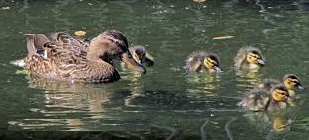
The nesting period can be very stressful for the female since she lays more than half her body weight in
eggs. She requires a lot of rest and a feeding/loafing area that is safe from predators. When seeking out a
suitable nesting site, the female's preferences are areas that are well concealed, inaccessible to ground
predators, or have few predators nearby. This can include nesting sites in urban areas such as roof gardens,
enclosed courtyards, and flower boxes on window ledges and balconies more than one story up, which the
ducklings cannot leave safely without human intervention. The clutch is 8-13 eggs, which are incubated for
27-28 days to hatching with 50-60 days to fledgling. The ducklings are precocial and fully capable of
swimming as soon as they hatch. However, filial imprinting compels them to instinctively stay near the
mother not only for warmth and protection but also to learn about and remember their habitat as well as how
and where to forage for food. When ducklings mature into flight-capable juveniles, they learn about and
remember their traditional migratory routes (unless they are born and raised in captivity). After this,
the juveniles and the mother may either part or remain together until the breeding season arrives.
During the breeding season, both male and female mallards can become aggressive, driving off competitors to
themselves or their mate by charging at them. Males tend to fight more than females, and attack each other
by repeatedly pecking at their rival's chest, ripping out feathers and even skin on rare occasions.
When they pair off with mating partners, often one or several drakes end up left out. This group sometimes
targets an isolated female duck, even one of a different species, and proceeds to chase and peck at her
until she weakens, at which point the males take turns copulating with the female. Lebret (1961) calls this
behaviour "Attempted Rape Flight" and Cramp and Simmons (1977) speak of "rape-intent flights". Male mallards
also occasionally chase other male ducks of a different species, and even each other, in the same way. In
one documented case of "homosexual necrophilia", a male mallard copulated with another male he was chasing
after the chased male died upon flying into a glass window. This paper was awarded with an Ig Nobel Prize
in 2003.
Mallards are opportunistically targeted by brood parasites, occasionally having eggs laid in their nests by
Redheads, ruddy ducks, lesser scaup, gadwalls, northern shovelers, northern pintails, cinnamon teal,
common goldeneyes, and other mallards. These eggs are generally accepted when they resemble the eggs of the
host mallard, although the hen may attempt to eject them or even abandon the nest if parasitism occurs
during egg laying.



